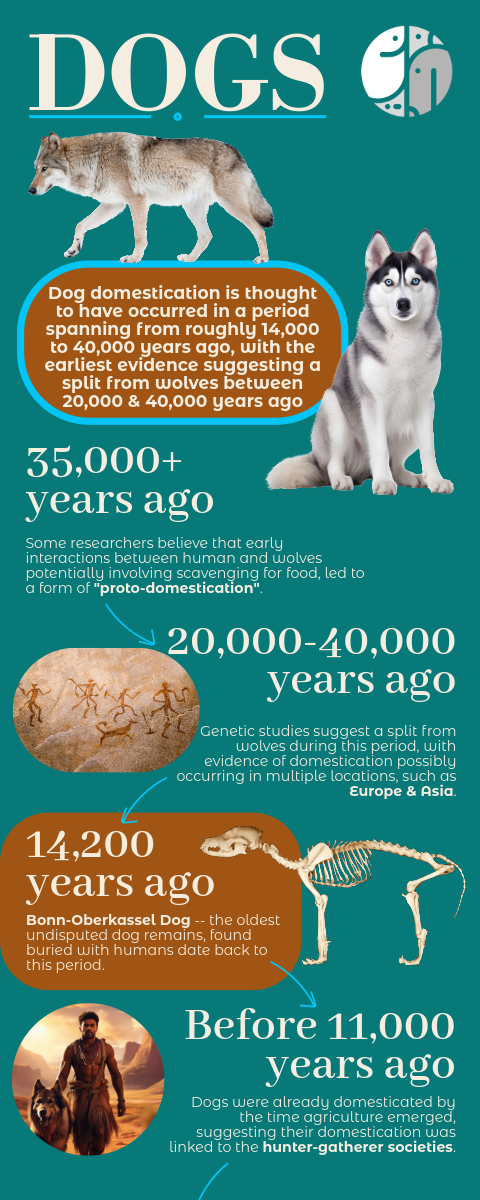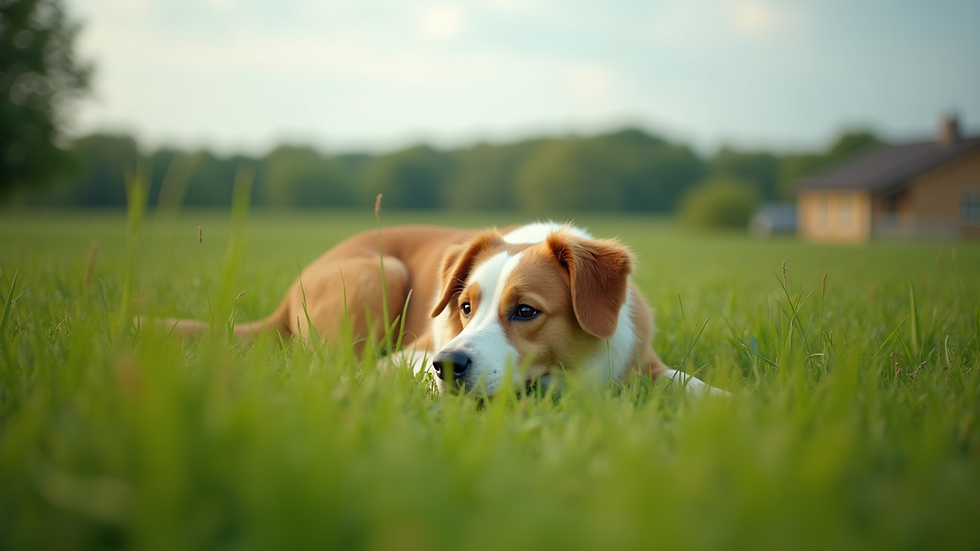Dog Domestication: From Wolves to Beloved Companions
- Steffi Thake

- Jul 31
- 4 min read
Updated: Aug 1
Dogs have stood by our sides for thousands of years. How did these remarkable creatures transform from wild wolves into our cherished pets? The story is complex and captivating. It evolved through a mix of chance and mutual benefit, creating a unique bond between humans and dogs. Two main theories—self-domestication and mutualism—offer insights into this extraordinary relationship.


Self-Domestication
The self-domestication theory suggests that over time, wolves that were less fearful of humans started scavenging near human settlements. Those wolves that showed friendlier behaviours had better access to food, thereby increasing their survival rates. This phenomenon explains how wolves gradually evolved into the sociable animals we now know as dogs.
Genetic studies have shown significant changes in dogs related to social behaviour, differentiating them from their wolf ancestors. For example, research by Hare et al. (2010) indicates that dogs possess specific genetic adaptations that enhance their ability to bond with humans. A significant finding from Larsen and Matocq (2019) shows that over 40 genes linked to stress responses and social interaction are more pronounced in dogs than in wolves. These genetic shifts display how dogs adapted to human environments, emphasising a long-term relationship.
However, some critics argue that this perspective oversimplifies the complex interactions between wolves and humans. Approaching humans involved significant risks for wolves. Relying solely on self-domestication fails to capture the nuanced dynamics that shaped this interaction over time.
Mutualism
The mutualism theory presents an alternative view. It posits that instead of a one-sided relationship, humans and wolves engaged in a partnership that benefited both. Wolves could provide protection and assistance in hunting, while humans offered a steady food source. This collaboration likely motivated the domestication process.
Nonetheless, mutualism presents its own challenges. The idea that a wild predator could willingly team up with humans suggests a sophisticated level of understanding and trust. Shipman (2015) highlights that taming a creature, driven by survival instincts, would be inherently complicated.
Despite these challenges, domestication has significantly benefited dogs. They started relying on humans for regular meals and shelter, drastically enhancing their survival compared to their wild relatives. Studies like those conducted by Axelsson et al. (2013) show that dogs developed adaptations for digesting starches, enabling them to thrive on human agricultural diets, which often comprise up to 60% starch by weight.
The social behaviour of dogs diverged from that of wolves as well. Dogs actively seek human companionship, regardless of their past experiences. This shift has paved the way for dogs to find their unique roles as beloved companions in human households.

The Downsides of Domestication
Domestication has not been entirely beneficial for dogs. Selective breeding, aimed at enhancing desirable traits, has led to reduced genetic diversity among dog breeds. This reduction makes them more vulnerable to various health problems. For example, certain breeds are prone to hip dysplasia, occurring in about 20% of larger breeds, and significant heart issues, which affect roughly 10% of all dogs.
Research by Marsden et al. (2015) raises awareness about these challenges, stressing the importance of being vigilant regarding health when breeding dogs.
A comparison of behaviours between wolves and dogs highlights critical differences. Dogs generally show more open and friendly social behaviours than their wild ancestors. This shift profoundly impacts how domesticated animals interact with humans and their environment, illustrating the importance of understanding their unique requirements.
The Bonds We Share Today
Today's relationship between dogs and humans reflects enduring themes of companionship and loyalty. From service dogs assisting people with disabilities to therapy dogs providing emotional support, the bond we share with our four-legged friends continues to evolve and strengthen.
Understanding the origins of this relationship helps modern pet owners appreciate the distinct traits of dogs. Together, humans and dogs have faced the challenges of survival, creating a connection that offers immense benefits. For example, studies show that owning a dog can reduce stress levels by 11% and increase physical activity by 30%, highlighting how much we gain from this bond.

The Path Forward in Our Relationship
The transformation from wild wolves to beloved companions showcases an intricate relationship that has evolved through cooperation, adaptation, and time. Dogs and humans have forged a lasting partnership based on shared experiences and interests.
By learning about self-domestication and mutualism, we deepen our appreciation for these incredible animals. This knowledge encourages responsible pet ownership and helps ensure the health and happiness of future canine generations.
With every wagging tail and gentle nuzzle, dogs continue to enrich our lives, proving that the bond formed all those years ago remains as strong and vital today as ever.
References
Axelsson, E., Ratnakumar, A., Arendt, M.-L., Maqbool, K., Webster, M.T., Perloski, M., Liberg, O., Arnemo, J.M., Hedhammar, Å. and Lindblad-Toh, K. (2013). The genomic signature of dog domestication reveals adaptation to a starch-rich diet. Nature, 495(7441), pp.360–364. doi:https://doi.org/10.1038/nature11837.
Dockrill, P. (2015). The Domestication of Dogs Has Caused Harmful Genetic Changes, Study Finds. [online] ScienceAlert. Available at: https://www.sciencealert.com/the-domestication-of-dogs-has-caused-harmful-genetic-changes-study-finds
Larsen, P.A. and Matocq, M.D. (2019). Emerging genomic applications in mammalian ecology, evolution, and conservation. Journal of Mammalogy, 100(3), pp.786–801. doi:https://doi.org/10.1093/jmammal/gyy184
Hare, B., Rosati, A., Kaminski, J., Bräuer, J., Call, J. and Tomasello, M. (2010). The domestication hypothesis for dogs’ skills with human communication: a response to Udell et al. (2008) and Wynne et al. (2008). Animal Behaviour, 79(2), pp.e1–e6. doi:https://doi.org/10.1016/j.anbehav.2009.06.031
Lazzaroni, M., Range, F., Backes, J., Portele, K., Scheck, K. and Marshall-Pescini, S. (2020). The Effect of Domestication and Experience on the Social Interaction of Dogs and Wolves with a Human Companion. Frontiers in Psychology, [online] 11. doi:https://doi.org/10.3389/fpsyg.2020.00785
Marsden, C.D., Ortega-Del Vecchyo, D., O’Brien, D.P., Taylor, J.F., Ramirez, O., Vilà, C., Marques-Bonet, T., Schnabel, R.D., Wayne, R.K. and Lohmueller, K.E. (2015). Bottlenecks and selective sweeps during domestication have increased deleterious genetic variation in dogs. Proceedings of the National Academy of Sciences, 113(1), pp.152–157. doi:https://doi.org/10.1073/pnas.1512501113
OVA PBS Official (2020). Dog Tales: How Dogs Became Man’s Best Friend | Full Documentary | NOVA | PBS. [online] Accessed on 18 May, 2025 from: https://www.youtube.com/watch?v=7ucj-Crs-KQ
Shipman, P. (2015). How do you kill 86 mammoths? Taphonomic investigations of mammoth megasites. Quaternary International, 359-360, pp.38–46. doi:https://doi.org/10.1016/j.quaint.2014.04.048
Woodward, J. (2023). Unraveling Canine Origins: 4 Popular Dog Domestication Theories. [online] WuffStuff. Accessed on 18 May, 2025 from: https://www.wuff-stuff.co.uk/blogs/news/unraveling-canine-origins-4-popular-dog-domestication-theories




Comments